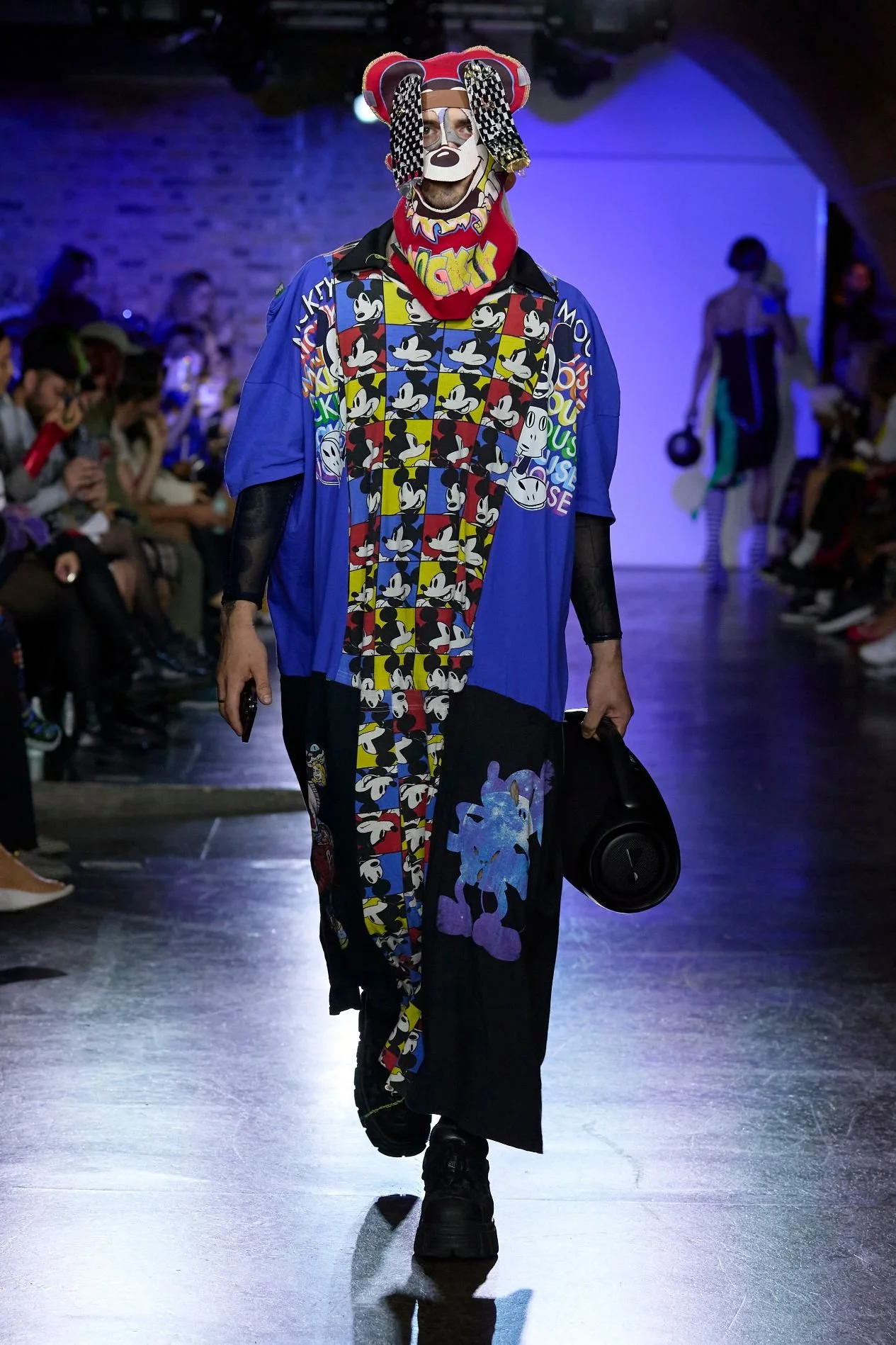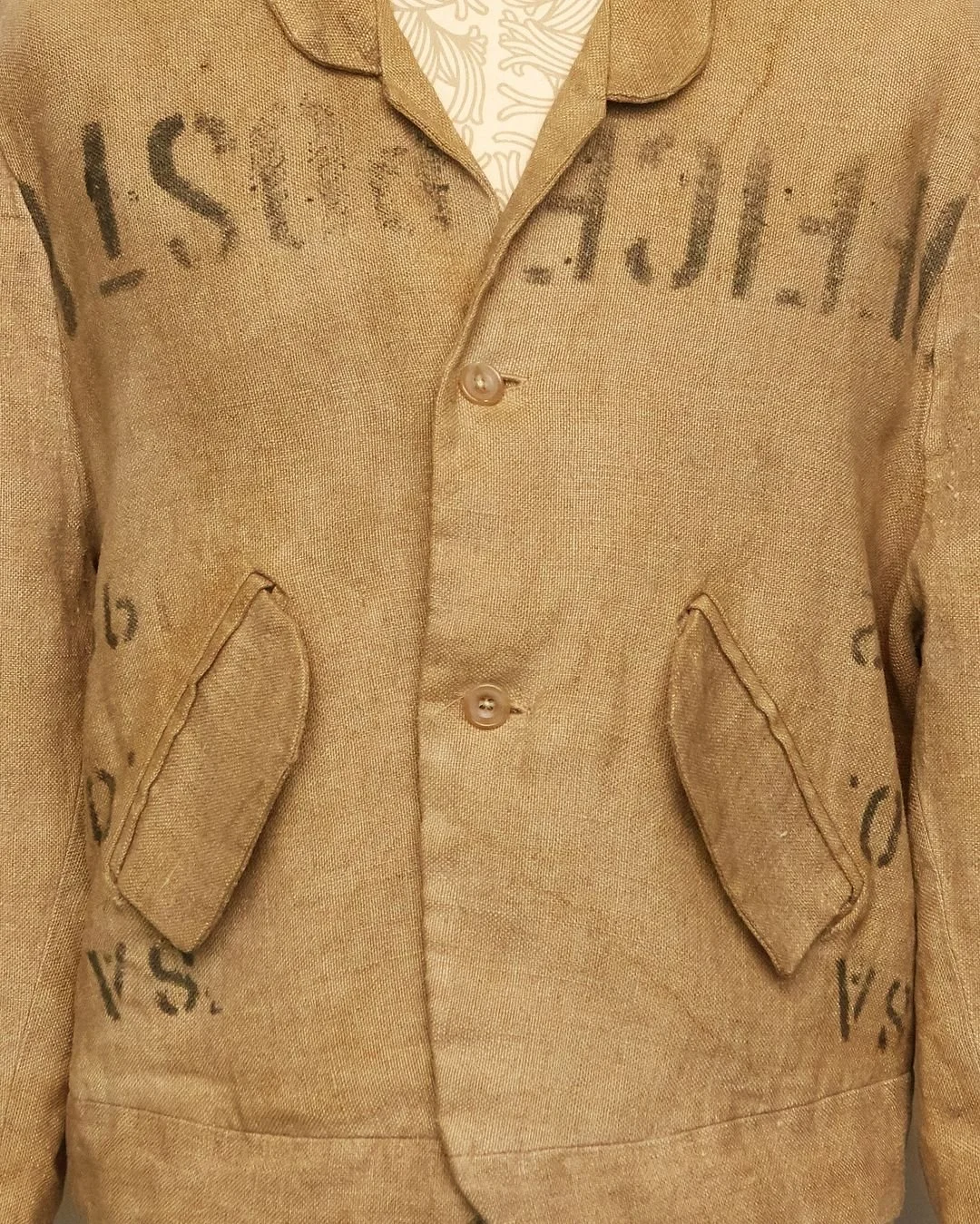In fashion month, the big brands with the big budgets dominate our feeds. But amidst the commercial noise of the contemporary fashion circus, gems still exist. The true artists who go their own way, and often set the future trend agenda (although they tend not to get the credit).
Our guest this week is one of them. He’s been shaking up the London underground scene since the ‘90s. Meet Dr NOKI, the original upcycler. Just don’t call him that…
NOKI SS24 LFW
NOKI does fashion on his own terms, including the language he prefers to describe his work. He “custom-builds” his “mashups” and “landfill drops”. It’s a practice that owes at debt to dadaism, and helped him make sense of his dyslexia when he was young. The story reaches to back into the ‘90s club scene, through the culture jamming of the No Logo years to end up at the cutting edge where art and fashion collide today.
Now, a new generation that’s interested in sustainability is discovering him for the first time. Last year, Hypebeast heralded NOKI as “a tried and true member of the sustainability movement — arguably being a founder of the word before it even really became a thing.”
But does he relate to that? How does he see his work? What inspired it all back in ‘90s London’s rave scene? And how does he see the future for fashion’s young waste warrior disruptors? Part fashion history lesson, part provocation to challenge our consumerist culture, this one’s an adventure - enjoy!
DR. LOVE This is how The Face magazine described Dr NOKI a few years ago: they said he’s “about as anti-fast fashion as they come, running riot since the '80s with the likes of Judy Blame and Katherine Hamnett (little did they know, they were spearheading a fashion revolution). For Noki, to customise clothes is to express oneself.” More here.
Rather than “upcycled” Noki uses the terms CUSTOM BUILD and MASHUP. “The DJs at the time were mashing up records,” he says. That was the start of it back in his raver days. Noki’s version of DNA stands for “direct Noki Action - like when you “chop a T-shirt, you can transform it into something else, take it back to its roots of textile and yarn, then rebuild it from that… you’ve broken nostalgia and produced something fresh.” He calls it “destroy to rebuild”.
Doesn’t it rather lose something when multi-national brands do it though? See, for reference, Fendace…
Here’s that GISELE i-D shoot by David Sims (above), the fledgling supermodel wears “customised Champion T-shirt by NOKI available from Pineal Eye, Broadwick St, London.” The Pineal Eye was an iconic Soho fashion boutique founded by Yuko Yabiku, Eric Portès and stylist Nicola Formichetti. They focused on homegrown talents doing something new with customization and the next generation coming out of Central Saint Martins. As described by one fan, it was: “the single most uninviting shop in the land. Which is kind of the point. Have a nice day now.” More here
ADBUSTERS was created by Canadian activists Kalle Lasn and Bill Schmalz in 1989. A “global collective of poets, punks and philosophers implementing radical design and media strategies to shake up complacent consumerist culture,” it garnered a cult following for its fake ads. More here.
DYSLEXIA “The word dyslexia comes from the Greek language and means difficulty with words. Individuals with dyslexia have trouble with reading and spelling despite having the ability to learn. Individuals with dyslexia just learn in a different way. Often these individuals, who have talented and productive minds, are said to have a language learning difference.” Via Australian Dyslexia Association.
Noki SS24 LFW
NOKI showed SS’24 at London fashion week. Here’s what the shownotes said about some of the materials used: The cans were “found crushed by the process of constant heavy traffic on the road … & packages have been collected from various bulging kitchen drawers and graffiti with Noki checkerboards to emulate the glitch of digital clutter on social media combined with the infamous Noki custom branding style mash up giving a nod to armour security and custom protection.”
AW23 Noki, nailed the context: “As we sleepwalk ever further towards the edge of environmental, economic, and social collapse,” he said ahead of his jaw-droppingly good show, chock full of unique upcycling ideas, at the Swiss Church in Covent Garden. “Noki’s fearless and uncompromising message and anti-establishment narrative conceived as a critique on capitalism and challenge toconsumerism, has never been more poignant or more powerful.” Word. Listen to Dr. Noki. He’s diagnosed the issue and written prescription – the question is, will you take it?
The CHECKERBOARD PRINT is a Noki signature. Via Instagram. “PROCESS” NOKI NESTT SS24
ABERDEEN IN THE ‘80s was
RAVE CULTURE & the Tshirt Nicked from The Mancunion: “Raving was about dressing down. Generally, rave-goers scrapped the designer labels often worn by clubbers in favour of oversized t-shirts, jeans and trainers. Outfits were fashioned to maximise comfort in a sweaty basement party. Specifically, the rise of Acid House music popularised the wearing of practical and utility garments to raves. Boiler suits, cargo trousers, and bucket hats were common choices. Best known amongst the Acid House styles was the smiley-face logo often appliqued onto bucket hats and printed on necklaces. The smiley-face was stamped on ecstasy pills, and so became an emblem of the carefree raver lifestyle...” We remember those smiley faces…
“Just as the music shows off its machine-made qualities, so too do the dress codes: performance sportswear and artificial fabrics dominate.” Via Dazed, read the rest here. Here’s a good read on how contemporary fashion has tried to co-opt rave (and every other sub culture) on NSS Magazine.
The term DANDY was commonly used to refer to sartorially flamboyant men in the 1800s, like the famous dandy Beau Brummell. As an adjective, dandy means excellent.
THE BRICKLAYERS ARMS was one of the key venues during the first wave of Shoreditch’s hipster culture in the late 90s.
HOUSE OF BEAUTY & CULTURE (HOBAC) was an avant-garde boutique, design studio, and crafts collective in late 1980s London, with key figures likeJudy Blame, John Moore, Cindy Palmano, and duo Fric and Frack. JUDY BLAME was, according to the New York Times, “an alchemist of the unlikely. He was fond of what he called mudlarking, collecting flotsam and junk from the banks of the Thames to incorporate into his pieces. “I’ll take a piece of rubbish and make it the chicest thing you’ve ever seen in your life,” he said in interviews. As the years went on, he would scavenge pins, buttons, bottle tops, coins, bones and cigarette papers. Nothing was off-limits... But like a fashion world Zelig, Mr. Blame was also involved with, and left traces on, many of the fashion moments and movements of the ’80s and onward. He worked closely with the fashion designer Christopher Nemeth, whose cobbled-together finery — made of canvas from his own paintings or purloined mail sacks — remains a cult fascination.” via NYT
“I‘ll take a piece of rubbish and make it the chicest thing you’ve ever seen in your life,” - Judy Blame
Christopher Nemeth “Post Office Jacket”, 1983.
LAST WORD
Here are the LINKS FOR WHAT CLARE MENTIONS IN THE INTRO…
Discover the Wear Next book here.
Stella’s Sustainable Market transformed the Marché Saxe-Breteuil in Paris with 21 stalls “allowing guests and the public to experience the pioneering materials featured in the collection, meet sustainable innovators and explore themes related to Stella.”
Discover HELEN KIRKUM’s fab sneakers here, and LFW presentation here. Listen to her on the pod here.
Here’s VIN + OMI’s “avant-gardening” story in the Times UK. For Spring ‘24 at LFW, they debuted a new plant fabric collaboration using butterburr from King Charles III’s Sandringham estate.
Listen to Ep 172 with Andrew Logan here, and ep 67 with Tamara Cincik here.
Scottish designer Hector Maclean is one to watch. Intrigued by the idea of J.W. Anderson’s plasticine shorts and hoodie? Look not further than here. Read about Marni’s show (which Clare thought was in Milan, but was actually in Paris) here, and behold the metal flowers here. Turns out the flowers were also made from tin-cans. TIN CANS ARE A THING RIGHT NOW!













